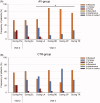Effects of audiovisual distraction on children's behaviour during dental treatment: a randomized controlled clinical trial
- PMID: 27409593
- PMCID: PMC4960510
- DOI: 10.1080/00016357.2016.1206211
Effects of audiovisual distraction on children's behaviour during dental treatment: a randomized controlled clinical trial
Abstract
Aim: Dental anxiety leads to undesirable distresses such as avoidance of dental treatment and increase stress among caregivers that consequently affect the treatment quality. The aim of this study was therefore to evaluate the effectiveness of viewing videotaped cartoons using an eyeglass system (i-theatre™) as an audiovisual (AV) distraction technique on behaviour and anxiety in children receiving dental restorative treatment.
Methods: Fifty-six consecutive children patients who presented for treatment and met inclusion criteria were included and randomly divided into two groups; a control group without distraction (CTR-group) and a distraction-group (AV-group). Three dental treatment visits were provided for each patient. Anxiety and cooperative behaviour were assessed with the Facial Image Scale (FIS) and the Modified Venham's clinical ratings of anxiety and cooperative behaviour scale (MVARS). The vital signs, blood pressure and pulse were also taken.
Results: The AV-group showed significantly lower MVARS scores than the CTR-group (p = 0.029), and the scores decreased significantly during treatment in the AV-group (p = 0.04). Further, the pulse rate was significantly increased in the CTR-group during injection with local anaesthesia (p = 0.02), but not in the AV-group.
Conclusion: AV distraction seems to be an effective method in reducing fear and anxiety in children during dental treatment. Further, children who used eyeglass goggle display as a distraction tool during dental treatment reported not only less anxiety than control groups but also showed more positive responses after injection with local anaesthesia. Hence, AV-distraction seems to be a useful tool to decrease the distress and dental anxiety during dental treatment.
Keywords: Children; anxiety; behaviour; dental fear; restorative treatment.
Figures



References
-
- Bankole OO, Aderinokun GA, Denloye OO, et al. Maternal and child’s anxiety – effect on child’s behaviour at dental appointments and treatments. Afr J Med Med Sci. 2002;31:349–352. - PubMed
-
- Folayan MO, Fatusi A. Effect of psychological management techniques on specific item score change during the management of dental fear in children. J Clin Pediatr Dent. 2005;29:335–340. - PubMed
-
- McCaul KD, Malott JM. Distraction and coping with pain. Psychol Bull. 1984;95:516–533. - PubMed
-
- Richmond BJ, Sato T. Enhancement of inferior temporal neurons during visual discrimination. J Neurophysiol. 1987;58:1292–1306. - PubMed
-
- Spitzer H, Desimone R, Moran J. Increased attention enhances both behavioral and neuronal performance. Science. 1988;240:338–340. - PubMed
Publication types
MeSH terms
LinkOut - more resources
Full Text Sources
Other Literature Sources
Medical
Miscellaneous
